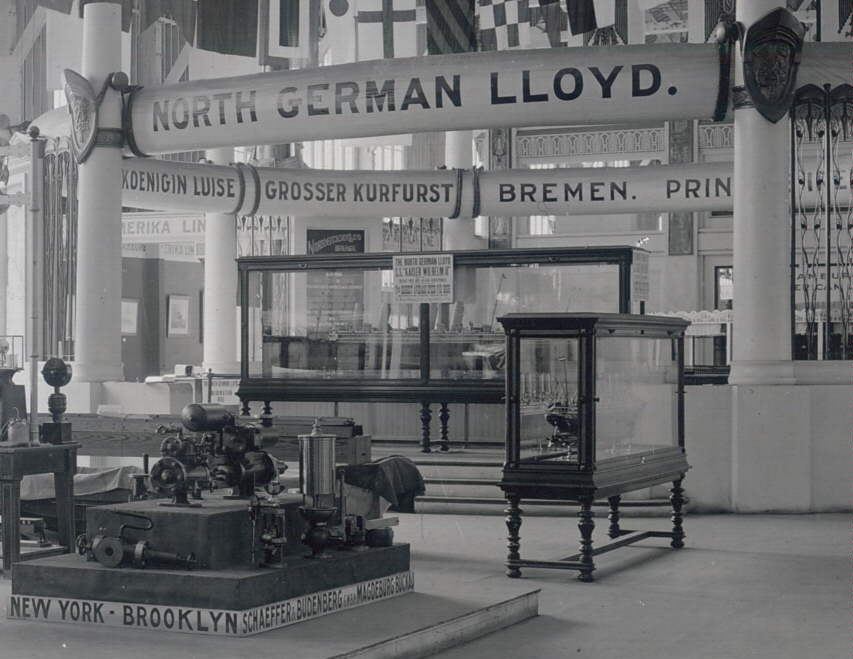A Ghost from the PastThere was something about her that fascinated. Looking like a prop from Raise the Titanic, she retained a majestic appearance in spite of her dilapidated condition. Undoubtedly she had been built to represent a specific liner, but which one? She clearly displayed early twentieth century characteristics. Twin-funneled liners from that period were numerous, but something about her profile wasn't right. She was proportionately too big and her superstructure unbalanced. Was something missing?
Prior to the launch of White Star's Olympic and Titanic, only three steamship companies operated liners of significant size - most sporting four funnels: Cunard, Hamburg-America Line and the Norddeutscher Lloyd. Cunard's Lusitania and Mauretania could easily be ruled out. Of the remaining five vessels, three had fewer decks. That left only two: the North German Lloyd's Kaiser Wilhelm II and Kronprinzessin Cecilie. The first clue to the model’s possible identity came in the form of a grainy photo in a catalogue of exhibitors at the Louisiana Purchase Exposition in St. Louis. The photo illustrated the North German Lloyd kiosk in the Palace of Transportation. Proudly displayed on the dais appeared to be a large, glass-encased, three-masted, four-funneled liner. In 1904 it could be only one vessel: the Kaiser Wilhelm II. Information in the auction listing indicated that the seller was located in central Illinois –not too far from St. Louis. Was this the same model -lost and then rediscovered after 108 years? The prospect was truly exciting! A call went out to the Missouri History Museum Library and Research Center in hope that their World’s Fair archive might contain photos of the gold medal-winning Norddeutscher Lloyd display. Indeed it did, and the image below was received. Though impossible to determine the exact scale from the photograph, the size of the two models appeared similar. Minor differences were noted in the paint scheme, but if the model had been repainted these could be explained. The cradles supporting the model, however, when viewed under magnification were
clearly different – much more elaborate and typical of those often associated with a builders’ model. Additionally they were located at different points under the hull. This led to the disappointing conclusion that this was likely not the same model. |
More questions were raised. If not an exhibit piece, what was a model of this size doing in the Midwest? Could she have been displayed in a steamship ticket office? If indeed she was it must have been in a city of significant size. The largest (and closest) North German Lloyd office was in Chicago. References to a display of art were found, but no photographs and no mention of any type of model materialized - yet another dead end. Other leads would have to be found and followed.
Many involved in online discussions, noting the model’s unique characteristics, seemed to agree that she had been manufactured by a German toymaker. Fleischmann was mentioned but the majority favored Märklin – considered by most to be a superior manufacturer. Whoever the maker, one expected that the creation of such an elaborate model – whether a production line item or one-of-a-kind – would have been recorded. German toy boats from the period are highly collectible and there are a number of experts in the field. Certainly the model must be illustrated or at least mentioned in some publication. Book after book was scanned, but to no avail. The absence of text dealing with company histories was telling. Little documentation had survived two World Wars. It appeared that this, as with previous lines of enquiry, would produce no results. Then, unexpectedly, the following appeared in The Allure of Toy Ships by Richard T. Claus, accompanying a photograph illustrating a 32" and a 24" Fleischmann toy liner: "Two of the largest Fleischmann clockwork liners… The Kronprinzessin Cecilie of 1907 was larger at 84”, but rather than being a toy it was a 1:100 scale model.” In an instant the model had both a name and a maker. The long-lost Kronprinzessin Cecilie had been found! But this merely brought forth more questions. Who had gone to such great lengths to deliberately alter her appearance? Why? How could such an amazing (not to mention large) artifact have been abandoned and forgotten for so long? Perhaps her manufacturer would be able to provide answers. At the very least there was now a direct line of enquiry to pursue. |
